
Pick up any chord dictionary, and one thought that should go through your mind is - TOO MANY CHORDS There is now way to memorize all those shapes. It would be better off learning how they came up with all those shapes. Most chord dictionaries are also just like pages transposed to all possible keys.

Beyond basic open position chords, basic movable form chords, and a core set of 4-part chords. There are just too many chords shapes too memorize. Learning the principles of how chords are constructed and the ukulele fingerboard are the way to go. You can then create more advanced chords like 9#11, 7#5-9, 13b5, 7+9 on the fly as needed from your core set of chords.

The art and science of chord fingering. Learning your basic open position chords in common keys. We have four fingers and there're all not equal. Some shorter then others and some stronger that others. Everybody's hand is a little different. This does play a role in fingering chords.

Commonly called "Jazz Chords", these more sophisticated, contemporary chord voicings find their way into a wide variety of music forms and styles. This lesson is the first on the series that builds your core foundation for these chords.

There're a lot different ways to show chord shapes, diagrams and images on a fretted instrument. This is the basic chord diagram I use in all my lessons and book. In this lesson the basic chord diagram as used for ukulele is explained.
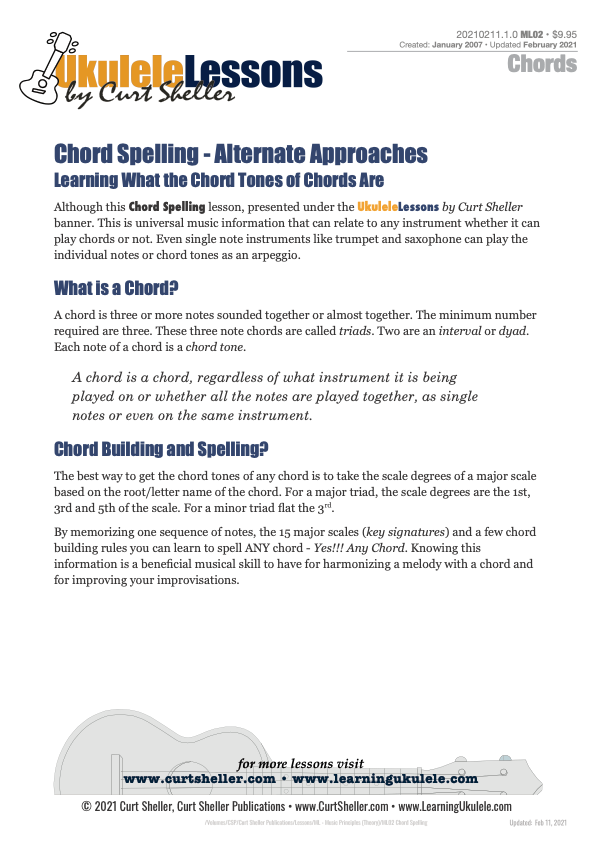
An alternate approach to determining the chord tones of any chord. Bottom-line is, it's the notes that make the chord, not the shape. A C chord is C, E, G - NOT this or that shape.

A non-traditional fingering for the G7 chord using the knowledge that the notes of a G7 chord are: G B D F.
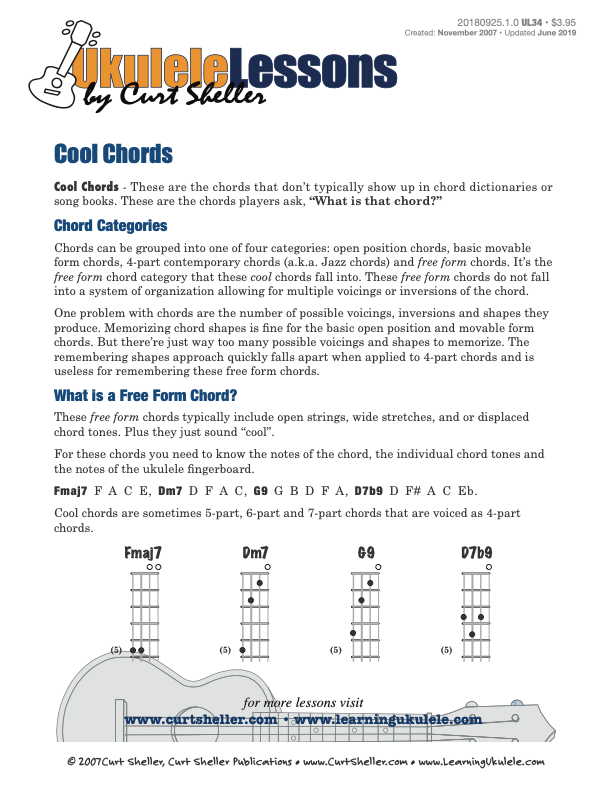
Cool Chords - These are the chords do not typically show up in chord dictionaries or song books. These are the chords players ask, "What is that chord?"

A series of weekly ukulele lessons originally presented throughout 2007 on movable ukulele chords as the "Ukulele Chord of The Week Series". Based on the Ukulele Chords book by Curt Sheller (me). It takes the open position chords and shows the movable form and the variations.

A Chord can have alternate names based on how it is being used. A chord's function is an important determining factor in naming a chord. So unless you know the harmonic function of a given chord, you might not be able to accurately name it.

Not all seventh chords are actually "dominant" seventh chords. This lesson covers when is a Dominant Seventh Chord NOT truly a Dominant seventh?

Upper Partials or extensions for chords are the 9th, 11th, and 13ths of a chord. The 9, 11 and 13 can be altered chord tones depending on the type: e.g: b9, #9, #11, b13. These numbers, the 9, 11 and 13 refer to the scale tone/chord tone relative to the major scale used for building all chords.

There are several ways to finger an open position D major chord. Depending on the context of how it's being used, one fingering might be better than another. Discover the "Mushy D" fingering.

The Big Six Core Chords is a series of lessons for building your core, essential 4-part chords. These chords commonly called jazz chords, are really just 4-part chords used in a wide range of musical styles. These chords include: Seventh , Major Seventh, Minor Seventh, Half Diminished Seventh or Minor Seven Flat Five, Diminished Seventh, and Augmented Seventh. These six chords form a core set of chords.

Naturally, for Ukuleles, all chords need to be voiced using only the four strings available. You would think that this is limiting, when in actuality it's quite liberating when you learn the makeup of chords. Chords can be categorized into four categories: “Open Position Chords”, “Movable Form Chords”, “4-part - a.k.a. Jazz Chords”, and “Free Form Chords.”

Alternate fingerings for F7 in C tuning. The same fingerings would apply to C7 in G tuning and G7 in D tuning.

Beyond basic open position chords, basic movable form chords and a core set of 4-part chords. There are just too many chords shapes too memorize. Learning the principles of how chords are constructed and the ukulele fingerboard are the way to go. Then you can create more advanced chords like 9#11, 7#5-9, 13b5, 7+9 on the fly as needed.

In music or music theory, a triad is a three-note chord (or, more generally, any set of three notes, pitches, or tones). Triads can be used harmonically, as chords and melodically, as single notes. These lessons explore both. Using triads as chords like any other chord and using triads as a basis for creating melodies and improvising.

"Diminished Seventh Passing Chord - Example J". From the book A Guide to Blues Progressions for Ukulele from A to Z.

"Major Quick Four Progression - Example D". From the book A Guide to Blues Progressions for Ukulele from A to Z.
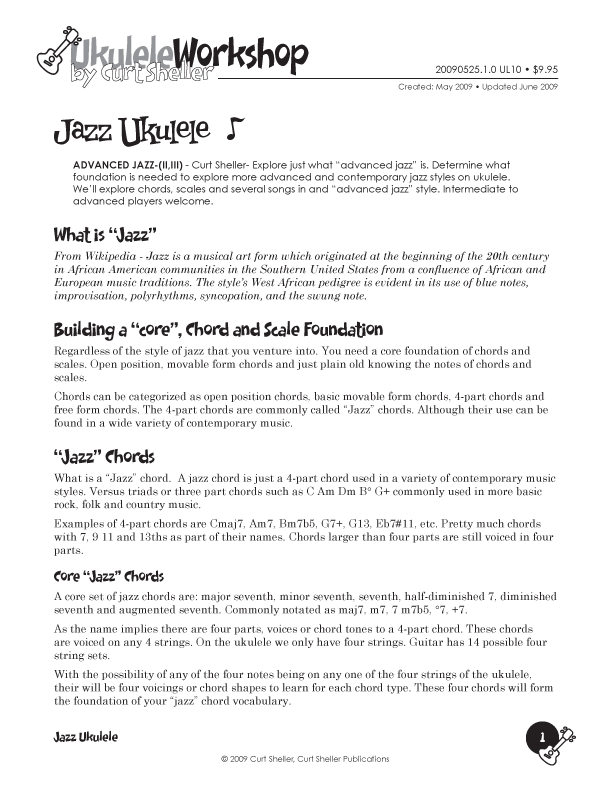
Wikipedia defines "Jazz" as a musical art form which originated at the beginning of the 20th century in African American communities in the Southern United States from a confluence of African and European music traditions. The style's West African pedigree is evident in its use of blue notes, improvisation, polyrhythms, syncopation, and the swung note.

"Transposition" is the process of moving a note, chord, scale or any musical passage from one key to another key. All music can be transposed, from a single note to a complex musical score. This lesson deals with transposing chords on ukulele and transposing chords.

"Hearing The Changes" is knowing what the chords of a song or chord progression are and when they change. This lesson gets you on the road to developing this ability. This involves know the chords of the keys and scales that are used for common progressions and songs. And the ability to recognize the sound of intervals, the distance between intervals.

Using chord "Voice Leading" principles we will explore all 4 voicings of core seventh chords using string family 1 2 3 4 chords.

The Blues are at the heart of all American music. It has influenced Country, Rock, Folk, Jazz, Bluegrass and just about every form of American music we listen to today. The Blues - a chord progression, a scale, a feeling. This lesson presents an introduction to the blues progression and a couple of scale position of the pentatonic scale to get you started improvising.

A chord substitution is when one chord replaces another chord or is used in addition to a current chord.

Sometimes referred to as cowboy or folk chords. These chords are played in the fret one, two, and three are of the guitar neck and include at least one open string. Technically the open position includes the open strings and frets one, two, three and four. These are typically the first chords anyone learning to play the guitar learn.

The "E/F Movable Barre Form" chords are movable form chords based on the open position E, Em, E7, and Em7 chords. With the root on string six, these chords can be transposed to ANY key.

The "A/Bb Movable Barre Form" chords are movable form barre chords based on the open position A, Am, A7 and Am7 chords. With the root on string five, these chord can be transposed to ANY key.

A cool chord is most likely a Free Form chord. A free form chord typically includes open strings, wide stretches, displaced chord tones and or chord voicings. Plus they just sound cool.

A "Substitution" is when a chord replaces or is used in addition to an existing chord. Chords can have an active or passive quality to them. Active chords tend to be restless and want to move on to other chords. Passive chords tend to offer a feeling of rest and resolution. This cycle of active and passive chords are what gives chord progressions their feeling of movement.

Taking a movable "F7" chord, you can derive each of the Big Six Core Chords. 7, maj7, m7, m7b5, dim7, and aug7 from that voicing.

Taking a movable "F7" chord, you can derive each of the Big Six Core Chords. 7, maj7, m7, m7b5, dim7, and aug7 from that voicing.

Taking a movable "F7" chord, you can derive each of the Big Six Core Chords. 7, maj7, m7, m7b5, dim7, and aug7 from that voicing.

Taking a movable "F7" chord, you can derive each of the Big Six Core Chords. 7, maj7, m7, m7b5, dim7, and aug7 from that voicing.

A core set of basic ukulele chords that ALL Ukulele players should know in the five common keys of C, G, D, A and E. With the possible seventh chords for the same common keys. The chart is organized in common keys and covers basic chords in these keys.

A core set of basic ukulele chords that ALL Left Handed Ukulele players should know in the five common keys of C, G, D, A and E. With the possible seventh chords for the same common keys. The chart is organized in common keys and covers basic chords in these keys.

Every wonder why certain chords seem to popup together time and time again? All harmonic or chord movement in a chord progression is a combination of the active and passive quality of individual chords within the progression or song. Chords provide tension and resolution, the feeling of movement and non-movement in songs and progressions.

F#m7b5 or F# half-diminished seven is a common chord in the key of G major and Em - especially Em.

Using the blues progression will can explore all voicings on string family 1 2 3 4. Using Voice Leading principles we will explore all 4 voicings of a seventh chords. To goal here is to play a different voicing in each measure. By transposing the C7 voicings to F7 (up 5 frets) and G7 (up 2 frets from F7).

Happy New Year! What better way to start the new year off than by learning a new ukulele chord every day of the year? The chord for January 1st is C. Originally started in 2013, this is a great way to review and learn your chords.

Learn a new Ukulele chord every day of the year. The chord for January 2nd is F. January 2nd happens to be my (Curt) birthday. Sorry, Mom and Dad, you didn't get that tax deduction (USA).

Learn a new Ukulele chord every day of the year. The chord for January 3rd is G. G is a primary chord in the common keys of G, C, and D.

Learn a new Ukulele chord every day of the year. The chord for January 4th is G7

Learn a new Ukulele chord every day of the year. The chord for January 5th is Dm The 'm' is pronounced 'minor'.

Learn a new Ukulele chord every day of the year. The chord for January 6th is Em The 'm' is pronounced 'minor'.

Learn a new Ukulele chord every day of the year. The chord for January 7th is Am The 'm' is pronounced 'minor'. This chord, discovered deep in the Lehigh Coal & Navigation Company's coal mine in Mauch Chunk, Carbon County of Pennsylvania by Am.

Learn a new Ukulele chord every day of the year. The chord for January 8th is Cadd9. Cadd9 is a great contemporary chord in wide use in a variety of styles.

Learn a new Ukulele chord every day of the year. The chord for January 9th is Cadd2. Cadd2 is a great contemporary chord in wide use in a variety of styles.

Learn a new Ukulele chord every day of the year. The chord for January 10th is C7

Learn a new Ukulele chord every day of the year. The chord for January 11th is D7. This partial D7 is ofter referred to as the Hawaiian D7 chord after its use in the Chord sequence C D7 G7, a common turnaround in Hawaiian music. So much so that it's called the Hawaiian Turnaround.

Learn a new Ukulele chord every day of the year. The chord for January 12th is E7

Learn a new Ukulele chord every day of the year. The chord for January 13th is Gsus4

Learn a new Ukulele chord every day of the year. The chord for January 14th is A7

Learn a new Ukulele chord every day of the year. The chord for January 15th is Fm.

Learn a new Ukulele chord every day of the year. The chord for January 16th is Cm.

Learn a new Ukulele chord every day of the year. The chord for January 17th is E.

Learn a new Ukulele chord every day of the year. The chord for January 18th is C6.

Learn a new Ukulele chord every day of the year. The chord for January 19th is B7.

Learn a new Ukulele chord every day of the year. The chord for January 20th is D.

Learn a new Ukulele chord every day of the year. The chord for January 21st is A.

Learn a new Ukulele chord every day of the year. The chord for January 22nd is Eb.

Learn a new Ukulele chord every day of the year. The chord for January 23rd is Gm.

Learn a new Ukulele chord every day of the year. The chord for January 24th is C5.

Learn a new Ukulele chord every day of the year. The chord for January 25th is Cmaj7.

Learn a new Ukulele chord every day of the year. The chord for January 26th is Emaj7.

Learn a new Ukulele chord every day of the year. The chord for January 27th is Amaj7.

Learn a new Ukulele chord every day of the year. The chord for January 28th is C9

Learn a new Ukulele chord every day of the year. The chord for January 29th is Am7

Learn a new Ukulele chord every day of the year. The chord for January 30th is Asus4

Learn a new Ukulele chord every day of the year. The chord for January 31st is Csus4

Learn a new Ukulele chord every day of the year. The chord for February 1st is C#m

Learn a new Ukulele chord every day of the year. The chord for February 2nd is F#m

Learn a new Ukulele chord every day of the year. The chord for February 3rd is Bbmaj7

Learn a new Ukulele chord every day of the year. The chord for February 4th is Dsus2

Learn a new Ukulele chord every day of the year. The chord for February 5th is F5add2

Learn a new Ukulele chord every day of the year. The chord for February 6th is C5add2

Learn a new Ukulele chord every day of the year. The chord for February 7th is G5

Learn a new Ukulele chord every day of the year. The chord for February 8th is Gmaj7

Learn a new Ukulele chord every day of the year. The chord for February 9th is Cadd9sus4

Learn a new Ukulele chord every day of the year. The chord for February 10th is A9

Learn a new Ukulele chord every day of the year. The chord for February 11th is A13

Learn a new Ukulele chord every day of the year. The chord for February 12th is A13

Learn a new Ukulele chord every day of the year. The chord for February 13th is Bb5add2

Learn a new Ukulele chord every day of the year. The chord for February 14th is Csus2.

Learn a new Ukulele chord every day of the year. The chord for February 15th is Gsus2.

Learn a new Ukulele chord every day of the year. The chord for February 16th is C13.

Learn a new Ukulele chord every day of the year. The chord for February 17th is C7b9.

Learn a new Ukulele chord every day of the year. The chord for February 18th is Em7.

Learn a new Ukulele chord every day of the year. The chord for February 19th is G6.

Learn a new Ukulele chord every day of the year. The chord for February 20th is a diminished seventh chord.

Learn a new Ukulele chord every day of the year. The chord for February 21st is a Diminished Seventh chord.

Learn a new Ukulele chord every day of the year. The chord for February 22nd is F#m7b5.

Learn a new Ukulele chord every day of the year. The chord for February 23rd is Asus4.

Learn a new Ukulele chord every day of the year. The chord for February 24th is A+.

Learn a new Ukulele chord every day of the year. The chord for February 25th is Cmaj9.

Learn a new Ukulele chord every day of the year. The chord for February 26th is Amaj9.

Learn a new Ukulele chord every day of the year. The chord for February 27th is Am9.

Learn a new Ukulele chord every day of the year. The chord for February 28th is Em9.

Learn a new Ukulele chord every day of the year. The chord for February 29th is ( see ya' again in 2028).

Learn a new Ukulele chord every day of the year. The chord for March 3rd is F7. We are now entering into the so-called “Jazz” chord, world of chords. Technically “Jazz” chords are simply 4-part contemporary chords that find the use in a wide variety of traditional and contemporary music.

Learn a new Ukulele chord every day of the year. The chord for March 4th is C7.

Learn a new Ukulele chord every day of the year. The chord for March 5th is G7.

Learn a new Ukulele chord every day of the year. The chord for March 6th is D7.

Learn a new Ukulele chord every day of the year. The chord for March 7th is A7.

Learn a new Ukulele chord every day of the year. The chord for March 8th is E7.

Learn a new Ukulele chord every day of the year. The chord for March 10th is B7.

Learn a new Ukulele chord every day of the year. The chord for March 11th is Eb7.

Learn a new Ukulele chord every day of the year. The chord for March 12th is Ab7.

Learn a new Ukulele chord every day of the year. The chord for March 13th is Db7.

Learn a new Ukulele chord every day of the year. The chord for March 14th is Ab7.

Learn a new Ukulele chord every day of the year. The chord for March 15th is Db7.

Learn a new Ukulele chord every day of the year. The chord for March 16th is C9.

Learn a new Ukulele Chord a Day for every day of the year. The chord for March 17th is F9.

Learn a new Ukulele chord every day of the year. The chord for March 18th is G9.

Learn a new Ukulele chord every day of the year. The chord for March 19th is A9.

Learn a new Ukulele chord every day of the year. The chord for March 20th is D9.

Learn a new Ukulele chord every day of the year. The chord for March 21st is E9.

Learn a new Ukulele chord every day of the year. The chord for March 22nd is C13.

Learn a new Ukulele chord every day of the year. The chord for March 23rd is C13.

Learn a new Ukulele chord every day of the year. The chord for March 24th is F7.

Learn a new Ukulele chord every day of the year. The chord for March 25th is F7#5.

Learn a new Ukulele chord every day of the year. The chord for March 26th is F9#5.

Learn a new Ukulele chord every day of the year. The chord for March 27th is F7b9#5.

Learn a new Ukulele chord every day of the year. The chord for March 30th is F7#9#5.

Learn a new Ukulele chord every day of the year. The chord for March 31st is C13#9.

Too many chord shapes to memorize Hopefully, that is something you might have realized after three months into the Chord a Day saga. There are way too many chord shapes to memorize.

The traditional/standard guitar chord diagram is typically used for showing chords. It is also used for showing scales-shapes, licks, and runs.

Switching chords are all about finger independence and working together. This can be developed using the "double stop" fingering drills presented in this lesson. A "double stop" is a term borrowed from violin technique where you are stopping two strings or two notes - an interval.

Sometimes called the “learning key”, the key of C Major is one of the easiest keys to memorize and begin using. C major (often just C or key of C) is a musical major scale based on C, with pitches C D E F G A B C. Its key signature has no flats or sharps. Its relative minor is A minor A B C D E F G A B.

The Big Six Core Chords, Level I - F7, four voicings. The F7 is a 1 3 5 b7 of the major scale, based on the root of the chord. For F7 the chord tones are: F A C Eb. These ARE the four F7 chord voicings that are used for deriving other chords. If all else fails when trying to remember a particular chord you can go back to your base seventh chords and go through the chord formula for deriving the chord you need.

The Big Six Core Chords, Level I - Fm7, four voicings. The Fm7 is a 1 b3 5 b7 of the major scale, based on the root of the chord. For Fm7 the chord tones are: F A C Eb.
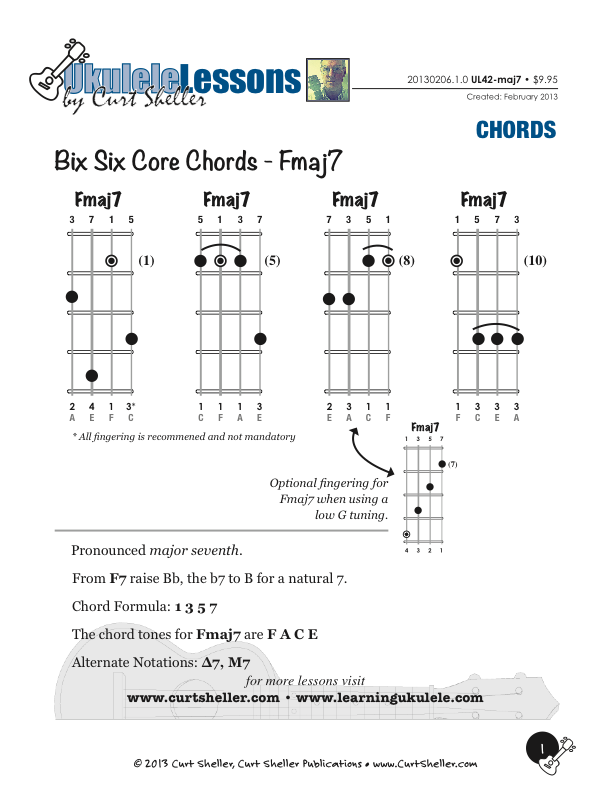
The Big Six Core Chords, Level I - Fmaj7, four voicings. Fmaj7 is a 1 3 5 7 of the major scale, based on the root of the chord. These are the four Fmaj7 chord voicings that will be used for deriving other major seventh derived chords. There are far too many chord shapes to memorize thousands of shapes.

The Big Six Core Chords, Level I - Fm7b5, four voicings. The Fm7b5 is a 1 b3 b5 b7 of the major scale, based on the root of the chord.

The Big Six Core Chords, Level I - Fdim7, four voicings. Fdim7 is a 1 b3 b5 bb7 of the major scale, based on the root of the chord. These are the four Fdim7 chord voicings that will be used for deriving other chords. There are far too many chord shapes to memorize thousands of shapes.

The Big Six Core Chords, LevelI - Faug7, four voicings. Faug7* is a 1 3 5# b7 of the major scale, based on the root of the chord.
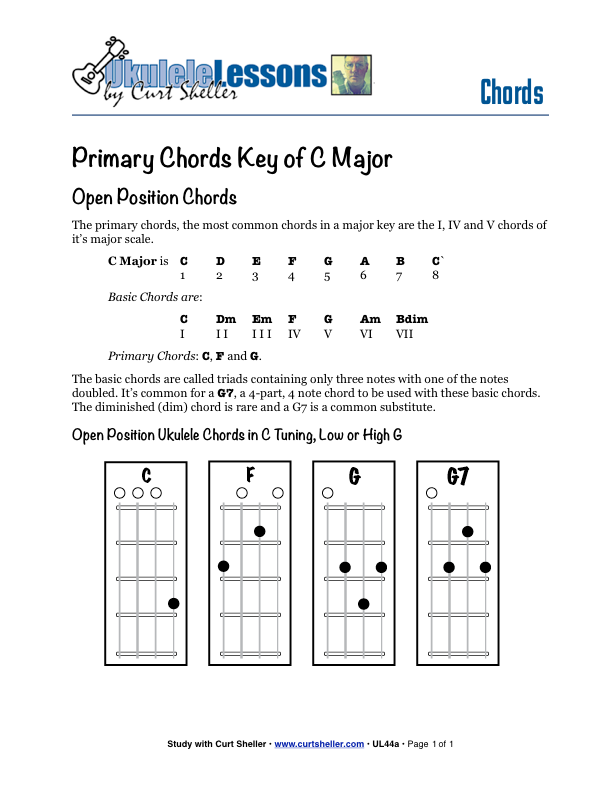
The primary chords for any major key are the I, IV and V chords of its corresponding major scale. For C Major, the primary chords are: C, F, G, and G7. From the primary and secondary chords of a major key, countless songs and chords progressions can be played.

The secondary chords for any major key are the II, III and VI chords of it's corresponding major scale. For C Major, the secondary chords are: Dm, Em and Am. From the primary and secondary chords of a major key, countless songs and chords progressions can be played.

A triad is a three note chord. In traditional chord theory there are four triad chord types: major, minor, diminished and augmented. This lesson covers the major and minor triads on string 1 2 3.

A triad is a three note chord. In traditional chord theory there are four triad chord types: major, minor, diminished and augmented. This lesson covers the augmented and diminished triads on strings 1 2 3.

A triad is a three note chord. In traditional chord theory there are four triad chord types: major, minor, diminished and augmented. This chart covers the major and minor triads on strings 2 3 4.

A triad is a three note chord. In traditional chord theory there are four triad chord types: major, minor, diminished and augmented. This lesson covers the augmented and diminished triads on strings 2 3 4.

A triad is a three note chord. In traditional chord theory there are four triad chord types: major, minor, diminished and augmented. This lesson covers the augmented and diminished triads on strings 1 2 3 4.

A triad is a three note chord. In traditional chord theory there are four triad chord types: major, minor, diminished and augmented. This chart covers the major and minor triads on strings 1 2 3 4.

A "Triad" is a three note chord. In traditional music theory, there are four triad chord types: major, minor, diminished, and augmented. Contemporary triads include sus and add.

The primary chords for any major key are the I, IV, and V chords of its corresponding major scale. For G Major the primary chords are: G, C, D, and D7.

Common chord progressions for the key of G. Using the primary and seconday chords for the key explore these common chord progressions for the key of G.

Common chord progressions for the key of A. Using the primary and seconday chords for the key explore these common chord progressions for the key of A.

Common chord progressions for the key of E. Using the primary and seconday chords for the key explore these common chord progressions for the key of E.

Common chord progressions for the key of B. Using the primary and seconday chords for the key explore these common chord progressions for the key of B.

Common chord progressions for the key of F#. Using the primary and seconday chords for the key explore these common chord progressions for the key of F#.

Common chord progressions for the key of C#. Using the primary and seconday chords for the key explore these common chord progressions for the key of C#.

Common chord progressions for the key of F. Using the primary and seconday chords for the key explore these common chord progressions for the key of F.

Common chord progressions for the key of Bb. Using the primary and seconday chords for the key explore these common chord progressions for the key of Bb.
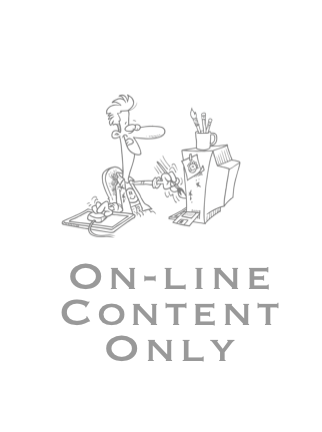
Common chord progressions for the key of Eb. Using the primary and seconday chords for the key explore these common chord progressions for the key of Eb.

Common chord progressions for the key of Ab. Using the primary and seconday chords for the key explore these common chord progressions for the key of Ab.

Common chord progressions for the key of Db. Using the primary and seconday chords for the key explore these common chord progressions for the key of Db.

Common chord progressions for the key of Gb. Using the primary and seconday chords for the key explore these common chord progressions for the key of Gb.

Using the primary and secondary chords for the key explore these common chord progressions for the key of Cb. The key of Cb is a pretty rare key but actually an easy key to relate to the key of C. The key of C has ALL natural notes and the key of Cb has all flat notes for the scale: Cb Db Eb Fb Gb Ab Bb Cb`. The names of the notes are the easy part, the chords are typically played as movable form chords with only the Fb ( the enharmonic equivalent name is E ) available as an open string in the C tuning.

Basic and Quick Change blues chord progressions in the key of C major using the core 7th chords from the Big Six series of lessons. This is a great way to explore this core chord in various keys. These are the two most common blues progressions used in traditional and contemporary music.

Basic and Quick Change blues chord progressions in the key of G major using the core 7th chords from the Big Six series of lessons. This is great way to explore this core chord in various keys. These are the two most common blues progressions used in traditional and contemporary music.

Basic and Quick Change blues chord progressions in the key of D major using the core 7th chords from the Big Six series of lessons. This is great way to explore this core chord in various keys.

Basic and Quick Change blues chord progressions in the key of A major using the core 7th chords from the Big Six series of lessons. This is great way to explore this core chord in various keys.

Basic and Quick Change blues chord progressions in the key of E major using the core 7th chords from the Big Six series of lessons. This is great way to explore this core chord in various keys.

Basic and Quick Change blues chord progressions in the key of F major using the core 7th chords from the Big Six series of lessons. This is great way to explore this core chord in various keys.

Basic and Quick Change blues chord progressions in the key of Bb major using the core 7th chords from the Big Six series of lessons. This is great way to explore this core chord in various keys.
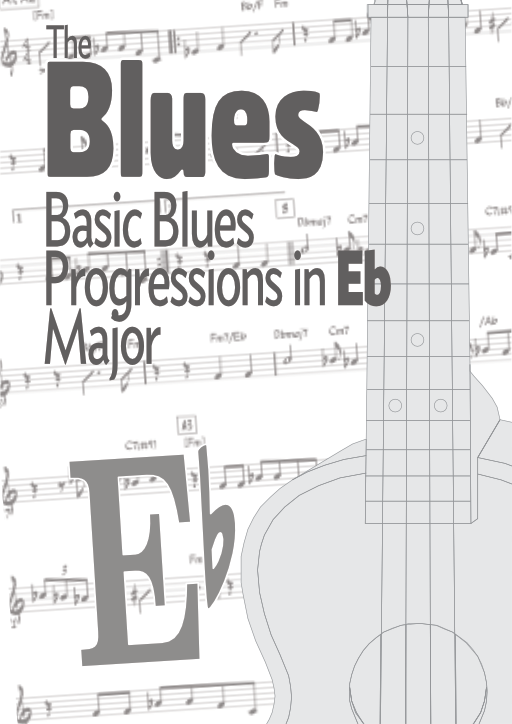
Basic and Quick Change blues chord progressions in the key of Eb major using the core 7th chords from the Big Six series of lessons. This is great way to explore this core chord in various keys.

Basic and Quick Change blues chord progressions in the key of Ab major using the core 7th chords from the Big Six series of lessons. This is great way to explore this core chord in various keys.

Basic and Quick Change blues chord progressions in the key of Db major using the core 7th chords from the Big Six series of lessons. This is great way to explore this core chord in various keys

Common chord progressions for the key of D. Using the primary and secondary chords for the key explore these common chord progressions for the key of D. D is one of the common keys that include C, G, *D, A, and E.

The primary chords for any major key are the I, IV, and V chords of its corresponding major scale. For D Major, the primary chords are: D, G, A, and A7. From the primary and secondary chords of a major key, countless songs and chords progressions can be played.

Exploring major triads using the primary chords of G major. Triads are one of the first chords that really bring to light the need to know the notes of the neck. This lesson shows the three voicings and the solutions for playing a common 1 4 1 5 progression using G, C and D triads on the string 1 2 3 set.

Building major triads using the primary chords of C major. Triads are one of the first chords that really bring to light the need to know the notes of the neck. This lesson shows the three voicings and the solutions for playing a common "1 4 1 5" progression using C, F and G triads on the string 1 2 3 set.

Example A blues progression from my book "A Guide To Blues Chord Progressions For Ukulele A To Z".

Example B blues progression from my book "A Guide To Blues Chord Progressions For Ukulele A To Z".

Example C blues progression from my book "A Guide To Blues Chord Progressions For Ukulele A To Z".

Example D blues progression from my book "A Guide To Blues Chord Progressions For Ukulele A To Z".

Example E blues progression from my book "A Guide To Blues Chord Progressions For Ukulele A To Z".

Example F blues progression from my book "A Guide To Blues Chord Progressions For Ukulele A To Z".

Example G blues progression from my book "A Guide To Blues Chord Progressions For Ukulele A To Z".

Example H blues progression from my book "A Guide To Blues Chord Progressions For Ukulele A To Z".

Example I blues progression from my book "A Guide To Blues Chord Progressions For Ukulele A To Z".
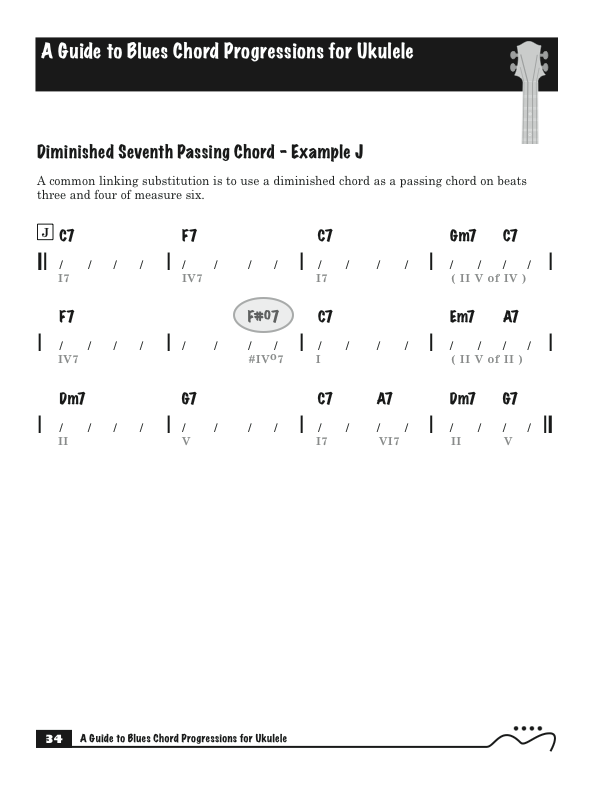
Example J blues progression from my book "A Guide To Blues Chord Progressions For Ukulele A To Z".

Example L blues progression from my book "A Guide To Blues Chord Progressions For Ukulele A To Z".

Example L blues progression from my book "A Guide To Blues Chord Progressions For Ukulele A To Z".

Example M blues progression from my book "A Guide To Blues Chord Progressions For Ukulele A To Z".

Example N blues progression from my book "A Guide To Blues Chord Progressions For Ukulele A To Z".

Example O blues progression from my book "A Guide To Blues Chord Progressions For Ukulele A To Z".

Example P blues progression from my book "A Guide To Blues Chord Progressions For Ukulele A To Z".

Example Q blues progression from my book "A Guide To Blues Chord Progressions For Ukulele A To Z".

Example R blues progression from my book "A Guide To Blues Chord Progressions For Ukulele A To Z".
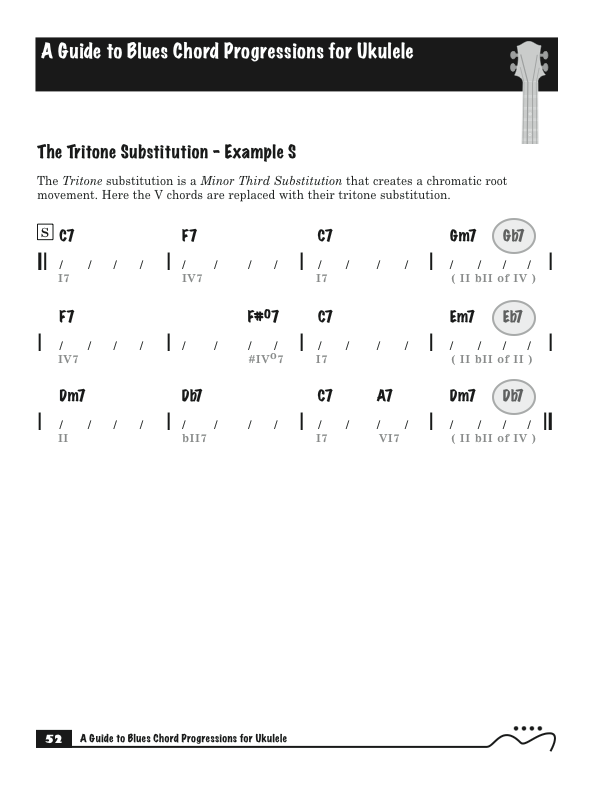
Example S blues progression from my book "A Guide To Blues Chord Progressions For Ukulele A To Z".

Example T blues progression from my book "A Guide To Blues Chord Progressions For Ukulele A To Z".

Example U blues progression from my book "A Guide To Blues Chord Progressions For Ukulele A To Z".

Example V blues progression from my book "A Guide To Blues Chord Progressions For Ukulele A To Z".

Example W blues progression from my book "A Guide To Blues Chord Progressions For Ukulele A To Z".

Example X blues progression from my book "A Guide To Blues Chord Progressions For Ukulele A To Z".

Example Y blues progression from my book "A Guide To Blues Chord Progressions For Ukulele A To Z".

Example Z blues progression from my book "A Guide To Blues Chord Progressions For Ukulele A To Z".

The Big Six Core Chords: "F6". This is the Level II of your core 4-part "Jazz" chords. The F6 is a 1 3 5 6 of the major scale, based on the root of the chord. A major 6th chord can be derived either from a seventh or major seventh chord. From a seventh chord lower the flat seventh one fret. From a major seventh chord lower the natural seventh two frets.

Using the jazz standard "All of Me" to explore jazz chords on ukulele.

Using the jazz standard "All of Me" to explore jazz chords on ukulele.

Using the jazz standard "Autumn Leaves" to explore jazz chords on ukulele.

Using the jazz standard "All the Things You Are" to explore jazz chords on ukulele.

Using the jazz standard "The Days of Wine and Roses" to explore jazz chords on ukulele.

Using the jazz standard "There Will Never Be Another You" to explore jazz chords on ukulele.

Using the jazz standard "Back Home in Indiana" to explore jazz chords on ukulele.

Using the jazz standard "Someday My Prince Will Come" to explore jazz chords on ukulele.

Using the jazz standard "Have You Met Miss Jones" to explore jazz chords on ukulele.

Using the jazz standard "Summer Samba" to explore jazz chords on ukulele.

Using the jazz standard "Sweet Georgia Brown" to explore jazz chords on ukulele.

A variation of the previous lessons using the jazz standard "Sweet Georgia Brown" to explore jazz chords on ukulele.

Using the classic Beatles cone by Paul McCartney "Yesterday" to explore jazz chords on ukulele.

Using the jazz standard "It's Only a Paper Moon" to explore jazz chords on ukulele.

Using the jazz standard "Take the A Train" to explore jazz chords on ukulele.

Using the jazz standard "Satin Doll" to explore jazz chords on ukulele. This also a great song for an introduction and exploring the very common, "II V" harmonic cell.

A variation using the jazz standard Satin Doll to explore jazz chords on ukulele.

"Where Do I Start?" This is a common question. This workshop/lesson covers ukulele tunings, learning the ukulele fingerboard, basic chords and strums. This workshop gets you rolling on having some fun playing the ukulele. This is the workshop-lesson handout that given to ukulele players attending the "Learning Ukulele - A Recipe for Success" beginner workshop.

The Big Six Core Chords - Level II: "FmL7" is created from the "1 b3 5 7" of the major scale, based on the root of the chord. For "FmL7" the chord tones are: F Ab C E. The L is a contemporary chord designation and refers to a large seventh, a major seventh.

The Big Six Core Chords: "Fm6". This is the Level II of your core 4-part "Jazz" chords. The Fm6 is a 1 b3 5 6 of the major scale, based on the root of the chord. A minor 6th chord can be derived either from a minor seventh or major sixth chord. From a minor seventh chord lower the flat seventh one fret. From a major sixth chord lower the natural third one fret.

The "A/Bb Movable Form Ukulele Chords", based on the open position "A, Am, and A7" chords allow you to transpose these to any key. The movable form chords are the next step after learning the core open position chords.

The "C/Db Movable Form Ukulele Chords", based on the open position "C, Cm, and C7" chords allow you to transpose these to any key. The movable form chords are the next step after learning the core open position chords.

The "G/Ab Movable Form Ukulele Chords", based on the open position "G, Gm, and G7" chords allow you to transpose these to any key. The movable form chords are the next step after learning the core open position chords.

Based on the open position seventh chords: A7, C7, E7, and G7. These movable seventh forms allow you to transpose the open position seventh chords to any key.

Power 5, sus and add movable form chords. These chords are common rock and contemporary chord forms.

There's actually a lot in common between songs when it comes to chord progressions. Here is an every growing list of songs that use the common 1 5 6 4 chord progression. This is a “Full Diatonic” chord progression, with each chord coming from its corresponding major scale. This common progression is called the “Four Chord, Pop Progression.”

The Big Six Core Chords - Level I: "F7" is created from the "1 3 5 b7" of the major scale, based on the root of the chord. For "F7" the chord tones are: F A C Eb. This lesson introduces the four "F7" voicings on the string set, strings 1, 2. 3, and 4. The Chords are shown for C Tuning, Low and High G.

Learning the locations of the chord tones - the actual names of the "F7" chords, the foundation chord for our Big Six Core Chords.

The Big Six Core Chords - "F7", four voicings. From shape to chord tones to intervals and back again. Really, learning what a chord is made of.

A triad is a three note chord. In traditional chord theory there are four traditional triad chord types: major, minor, diminished and augmented. And four contemporary triad chord types: sus2, sus4, add2 and add9.
This series of lessons explores contemporary suspended or sus chords using triads cover is earlier lessons of this series.

A triad is a three note chord. In traditional chord theory there are four traditional triad chord types: major, minor, diminished and augmented. And four contemporary triad chord types: sus2, sus4, add2 and add9. This series of lessons explores contemporary add chords using triads covered in earlier lessons of this series.

Listening to songs and wanting to play the same songs on ukulele – that's what draws most people to the ukulele. That and it looks like a load of fun and easy to play – which it is. Then you need to actually remember the songs that you're learning, so you can play them again. And, hopefully, not have to read them off a sheet all the time.

The ability to place a single finger across more than one string, a “barre” is an essential technique for chords as well single notes and double stops.

Common Jazz Chord Progressions - there is a lot more common between songs than you might think. This lessons show some common progressions and the jazz standards that use them.

These chords are movable chord forms based on core 4-part seventh chords and triads with duplicated and/or omitted notes.

A rare chord, a diminished triad with a major seventh. Used the support the melody when the melody is the major seventh.

A rare chord, an augmented triad with a major seventh. Used the support the melody when the melody is the major seventh.

The next series of chords that build on the Bix Six Core Chords and form the foundation for ALL your jazz chords include: Major Sixth ( 6 ), Minor Sixth ( m6 ) and Minor-Major Seventh ( mL7 ).

The next series of chords that build on the Bix Six Core Chords and form the foundation for ALL your jazz chords include: Diminished Major Seventh ( dimL7 ) and Augmented Major Seventh ( augL7 ). These chords are rare and used to support a major seventh melody.

A chord extension or upper partial are the chord tones above the octave and not one of the fundamental 4-part chord tones. These are the ninths, elevenths and thirteenths of chords. All chord extensions on ukulele will displace a fundamental chord tone. This is even true for guitar with the ability to add the extension to another string.

The "fifth", "ninth", "eleventh" and "thirteenth" of a chord can be altered. Alterations can be applied 1, 2 and 3 at a time. The alternations give a chord added color or tension.

The most important notes or chord tones in a chord are the notes that contribute most to the actual sound or “color” of the chord. For a major or minor triad, the third of the chord performs this function. For other chords, any note that makes it different from other chord types with the same root are the color tones.
This lesson is a more for less type of lesson exploring what notes are actually important in chords. The best place to start with this concept is 4-part chords and the Big Six Core Chords.

The remaining chords for The Big Six, Level I Core Chords. The Big Six chords include: Seventh 7, Major Seventh maj7, Minor Seventh m7, Half Diminished Seventh or Minor Seven Flat Five diminished 7 m7b5, Diminished Seventh o7 and Augmented Seventh +7. These six chords form a core set of chords.

The basic first chords most players learn. There are the chords in the first, second, third, and fourth frets of the ukulele and include at least one open string.

Sometimes called barre chords, these chords venture beyond the third fret.

A "Triad" is a three note chord. In traditional chord theory there are four traditional triad chord types: major, minor, diminished and augmented. And four contemporary triad chord types: sus2, sus4, add2 and add9. Triads can be used harmonically, as chords and melodically, as single notes. Triads are a great way to get started with creating melodic solos and improvising.

Core Chords is a series of lessons for building your 4-part chords. These chords commonly called jazz chords, are really just 4-part chords used in a wide range of musical styles. Beyond basic open position chords, basic movable form chords and a core set of 4-part chords. There are just too many chords shapes too memorize. Learning the principles of how chords are constructed and the ukulele fingerboard are the way to go. Then you can create more advanced chords like 9#11, 7#5-9, 13b5, 7+9 on the fly as needed.

"Free Form" chords are those chords that do not fall into one of the other chord categories. They typically don't show up in chord dictionaries or software programs.

Creating "Melody and Chord Arrangements", in theory are as simple as harmonizing the melody with a chord. Which is playing a chord that has the melody note as the top note of the chord voicing. In practice it is a little more involved, but not much more.

"Core Chords" are a concept that I typically apply to 4-part chords and your more contemporary modern chords. This where a solid foundation of a core set of chords really help in learning the massive amount of chords that are required for play contemporary music or jazz on ukulele or guitar. Not such a task on ukulele with on one four string set of strings to build your 4-part chords vs. the theoretically possible 15 sets available for guitar.

A chord's name is comprised of it's letter name, either A, B, C, D, E, F, or G and it's type information symbols which encapsulates the instructions for building a chord.

This is a lesson with practice tips for getting the most out of each of the blues progressions in my book A to Z Blues Chord Progressions for Ukulele.
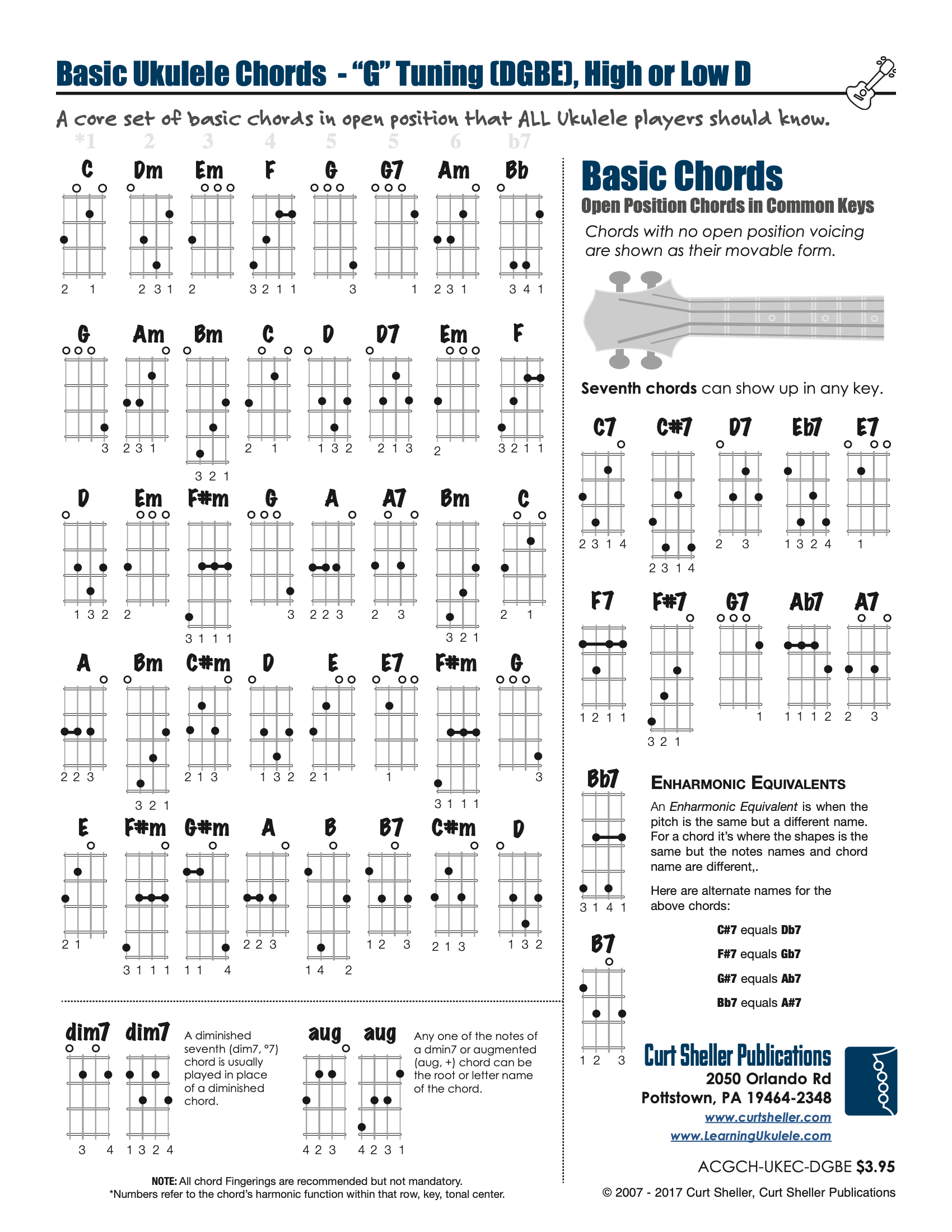
A core set of basic chords that ALL Ukulele players should know in common keys.
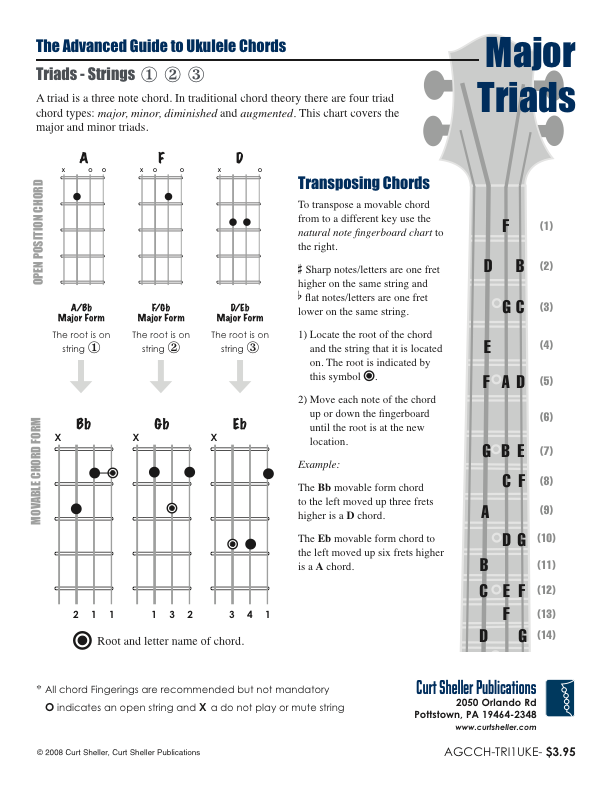
These chords are movable, three note chord forms. The triad is the chord

In the key of C major Pachelbel's Canon is: C G Am Em F C F G. This is a I V VI III IV I IV V in harmonic analysis notation. In Nashville Numbering it's 1 5 6 3 4 1 4 5. It is a full diatonic progression with all the chords coming from it's parent major scale. A bit of a varaition of the Four Chord Pop progression.

An overview of the Ukulele Chords and Chord Progression lessons available.

The "Mixolydian/Dominant" scale is one of the six essential scales that every ukulele player should know. Here are the chords for all 15 Mixolydian/Dominant scales.

The Ionian/Major scale is one of the six essential scales that every ukulele player should know. Here are the chords for all 15 Ionian/Major scales. From the Ionian/Major scale all other diatonic and pentatonic scales can be derived.
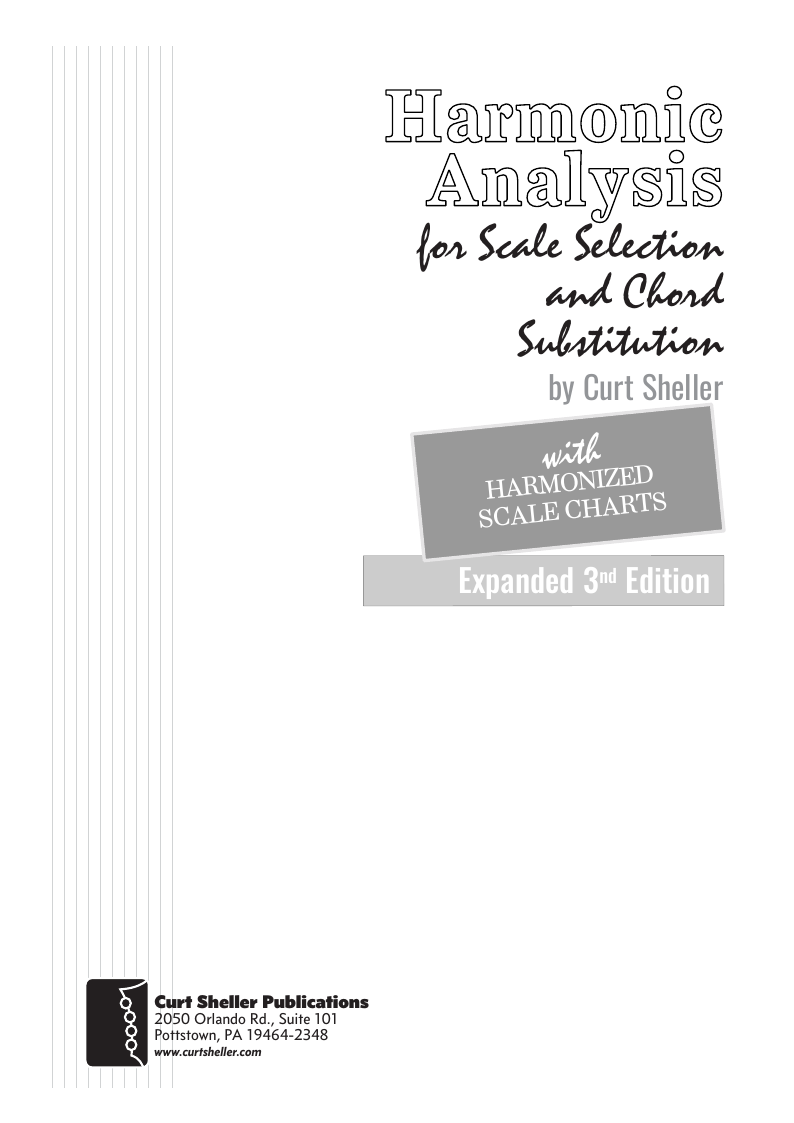
Harmonic Analysis ( HA ) is the process used to determine the harmonic function of chords within a chord progression. A chord progression is defined as a sequence of chords, each chord has a root and has a particular chord type. The relationship of a chord's root to a scale determines its function within that scale's tonality. Once a chord's function is identified, scale selections along with chord and scale substitutions can be made. This process is called Root Movement Analysis ( RMA ). This series of lessons are extracted from my book for use with individual private and on-line students. Each lesson directly corresponds the chapters in my book Harmonic Analysis for Scale Selection and Chord Substitution by Curt Sheller (me).

Exploring major triads using the primary chords of D major. Triads are one of the first chords that really bring to light the need to know the notes of the neck. This lessons shows the three voicings and the solutions for playing a common 1 4 1 5 progression using D, G and A triads on the string 1 2 3 set.

Learning the similarities between chord progressions and songs helps you remember a lot of songs. There's a lot more in common between songs than one might think. This series of lessons explores common chord progressions.

There are two approaches to learning chords, the song based approach and learning the fundamentals approach. I'm a big advocate of building a solid base of the fundamentals. A lot of players new to the ukulele like to jump right in and learn songs.

Fred Flintstone is the main character of the animated sitcom The Flintstones, which aired during prime-time on ABC during the original series' run from 1960 to 1966. Fred is the husband of Wilma Flintstone and father of Pebbles Flintstone. His best friend is his next door neighbor, Barney, who has a wife named Betty and an adopted son, named Bamm-Bamm.
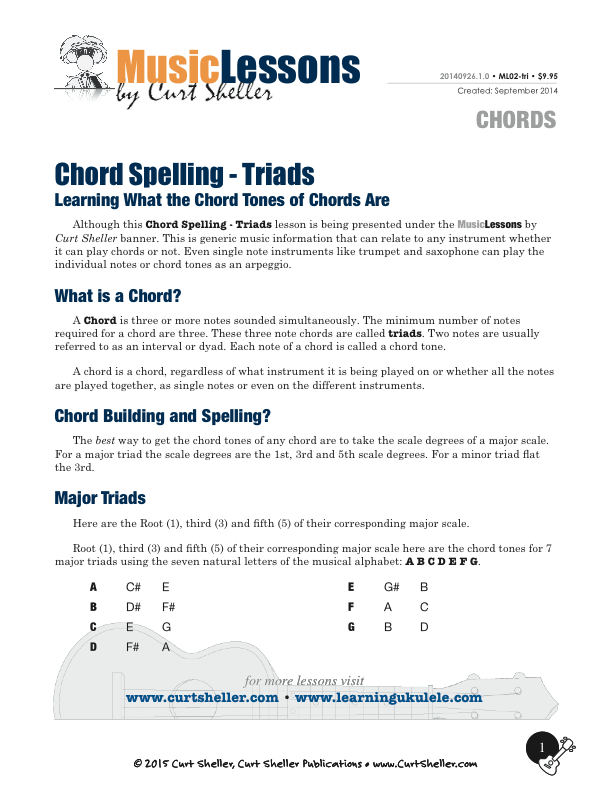
This lesson presents the traditional approach for learning the chord tones of chords with a little twist to make it a bit easier. A Chord is three or more notes sounded simultaneously - together or almost together. The minimum number of notes required for a chord are three. These three note chords are called triads. Two notes are usually referred to as an interval or dyad. Each note of a chord is called a chord tone.

A "Secondary Dominant" chord is defined as any seventh chord built on a scale root that is diatonic to the key that resolves up a perfect fourth or down a perfect fifth to a full diatonic chord. These chords function as a dominant (V) chord to the next chord, serving to temporarily tonicize the following chord.

Your first ukulele chord is typically an open position "C Major Chord." It's only one finger and ukulele players love to show new players this, the easiest, usable ukulele chord for new players. Especially someone coming from guitar where an open position C major is three fingers and not that easy as the first chord.

For Lesson Eight we'll add and build on the lesson and material from lesson four.

Learn a new Ukulele chord every day of the year. The chord for March 28th is F7b9b5.

Learn a new Ukulele chord every day of the year. The chord for March 29th is F7#9b5.

For Lesson Eight we'll add and build on the lesson and material from lesson four.

The Big Six chords include: Seventh 7, Major Seventh, Minor Seventh, Half Diminished Seventh or Minor Seven Flat Five diminished 7 , Diminished Seventh and Augmented Seventh. These six chords form a core set of chords.

Not to leave our guitar players out of the action here is a chart for basic chords for guitar. The basic open position chords that all guitar players should know. These are typically the first chords beginner learn.

A metronome is a device that produces an audible click or other sound at a regular interval that can be set by the user, typically in beats per minute (bpm).

"barre", the old English spelling vs. bar which refers to a measure of music, is used to indicate a placing of a finger across two or more strings. If covering all the strings it's called a full barre and if fewer than all the strings it’s a partial barre. It’s a classical guitar technic used for guitar, ukulele, mandolin and other fretted string instruments regardless of style.

Level III rhythmic syllable pairs for developing your ukulele strums vocabulary and sharpen your reading chops.

Level IV rhythmic syllable pairs for developing your ukulele strums vocabulary and sharpen your reading chops.

People have asked me about Clawhammer style. That is not really a style I have master, although I can teach it.

One of the first skills a ukulele player learns is the art and craft of strumming, playing rhythm. This refers to an accompaniment technique suitable for the singer - songwriter or someone who plays a support role for another instrument.

Music is a common language used world wide and recognized by musicians in lots of different countries even speaking different languages. This lesson gives a basic understanding on how to read a lead shot, song sheet, chord chart, etc...

Learn a new Ukulele chord every day of the year. The chord for March 1st is Bb. For transposition purposes today's the root on string one or four can be used. This is where really and I mean really knowing the notes of the ukulele fingerboard really pay off.

Learn a new Ukulele chord every day of the year. The chord for March 2nd is Bb7. Using the root on string one from yesterday's Bb chord allows you to reuse the transposition chart or knowledge for the Bb7 shown today.

You can’t play this chord on many other stringed instruments other than the ukulele. This is the ultimate C chord with only two C notes. In high G, C tuning three are the exact same C notes and a middle C.

Technique is the manner and degree to which one employs the technical skills of an endeavor. For ukulele or any instrument the use of the hands, It's the motor skills and the efficient application of the motor skills for the specific tasks that are need and required.
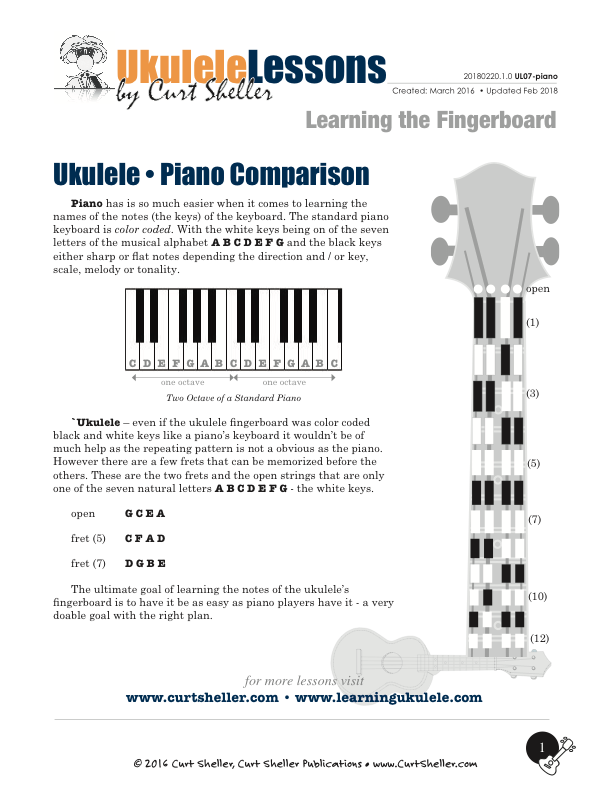
Piano has is so much easier when it comes to learning the names of the notes (the keys) of the keyboard. The standard piano keyboard is color coded. With the white keys being one of the seven letters of the musical alphabet "A B C D E F G" and the black keys either sharp or flat notes depending the direction and / or key, scale, melody or tonality.

This is a movable seventh chord. I use this at fret (5) for D7 in my arrangement of Take the A Train. This allows me to sustain the chord and grab the high E melody on string one at fret (7).

This is a scan of a typical first lesson that ALL students new to the ukulele might get in one of my private one-on-one lessons. View the full lesson for my notes and my comments on what doesn't make it on every the sheet. There's a lot that goes on in an individual private lesson and is different from student to student.

If there is one area of discussion that players recommendations are all over the board on - it's fingernails for classical guitar. The technique and subject for classica guitar is appropriate for ukulele as well. The ukulele is almost a mini classical guitar missing two strings.

Playing chords, chord progressions, and songs by ear is all about getting your ear to recognize the sound of chords and chord progressions and just like melodies, train the fingers and the hand to follow your inner ear and play these chords, chord progressions, and songs on demand.

This is cool, fun song that is part of a lot of Hawai'ian musicians repertoire and a lot of fun to play. I was always honored to have Gordon Velasco ask me to sit in with him and Debi and this was always on of my favorites to play and jam on. Basically an Andalusian chord progression: Am G F E7.




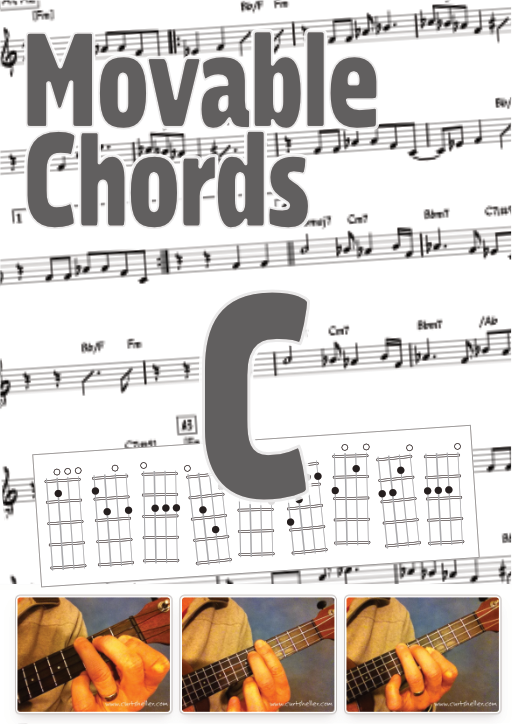














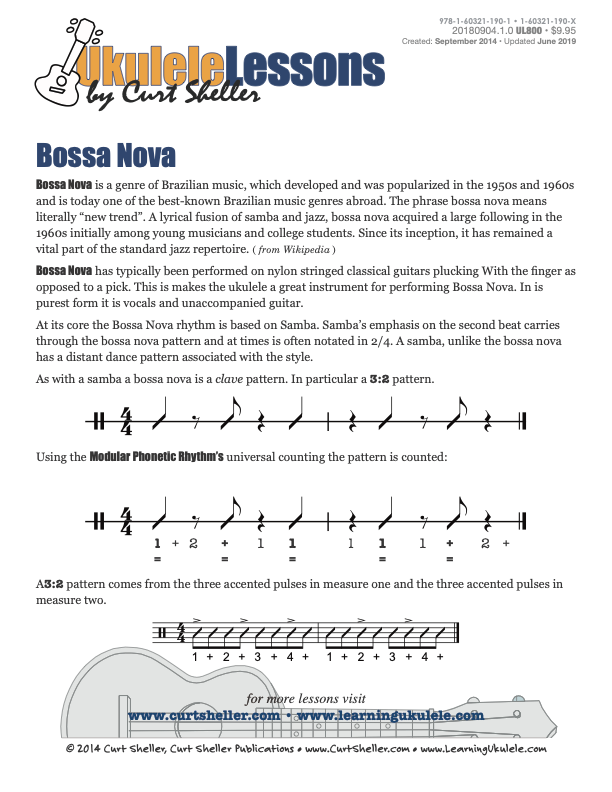




.jpg)